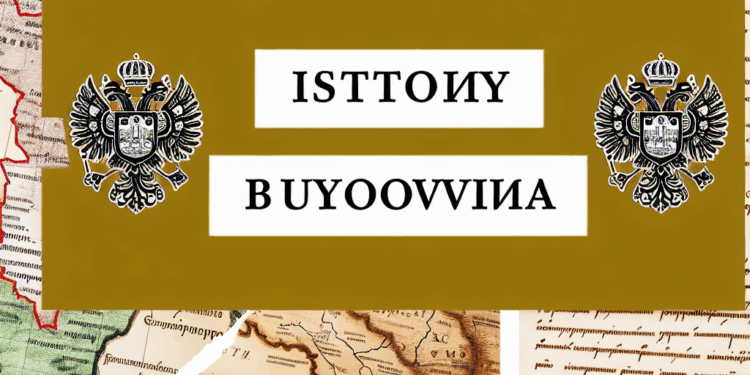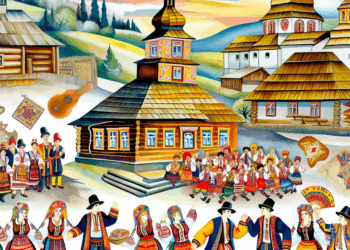Introduction
Bukovina is a historical region located in north-western Romania and south-western Ukraine, with a rich and complex history. During the twentieth century, the region has undergone many territorial changes, spanning different states and political regimes. This article highlights key events and annexations affecting the fate of Bukovina, from 1775, when the region became part of the Austrian Empire, to its modern borders.
Bukovina under Austrian rule (1775-1918)
In 1775, as part of the third partition of Poland, Bukovina was annexed by the Austrian Empire. This event marked the beginning of a new stage in the history of the region. Austrian rule lasted more than 140 years and was characterised by gradual modernisation and infrastructure development. The Greek Catholic Church as well as the Ukrainian and Romanian population of the region became the objects of attention of the Austrian authorities.
Bukovina was administratively organised as a separate province, which included cities such as Cernăuți, Suceava and others. During this period, the population increased significantly due to migrations from other regions. As a result of the multi-ethnic structure, different ethnicities coexisted in Bukovina: Romanians, Ukrainians, Jews, Germans and Ruthenians.
End of the First World War and change of borders (1918)
After the end of World War I and the collapse of the Austrian Empire in 1918, new geopolitical realities emerged. As a result of the Treaty of Vienna and subsequent peace agreements, Bukovina was annexed to Romania. This was part of the process of national self-determination, when the new government established “Greater Romania”.
During this period, the Romanian policy of “Romanisation” began, aiming to strengthen the Romanian language and culture. Bukovina became an important focal point of the Romanian national movement and its capital, Chernivtsi, became a cultural centre.
With the advent of Romanian rule, the population of the region gained new opportunities, but also faced difficulties related to ethnic relations and integration of different groups. The low level of the economy and political instability also created an environment for social conflicts.
Accession to the Soviet Union (1940)
According to the “Secret Protocol” to the Molotov-Ribbentrop Pact, in 1940, Bukovina was annexed by the Soviet Union. This anniversary is remembered not only for the change of power, but also for a series of repressions directed against the local population. The authorities carried out forced relocations, arrests and shootings of the Romanian and Jewish population.
Even with the social and economic modernisation brought by the Soviet regime, many human rights activists argue that the very spirit of multi-ethnicity that had characterised Bukovina in previous centuries was lost.
In 1941, World War II broke out and Bukovina was occupied by the Nazis. This was a particularly difficult time for the Jewish population, which was systematically persecuted and exterminated.
After World War II and the return to the Soviet Union (1944)
At the end of World War II and during the Tehran Conference organised in 1943, the victors granted the USSR the right to determine the borders in Eastern Europe. As a result, Bukovina came back under Soviet administration in 1944.
The region was integrated into the Ukrainian SSR, marking Romania’s final loss of control over Bukovina. This reshuffle affected the demographic composition: some Romanians left for Romania, while Russians and other nationalities began to move to Bukovina.
Soviet policy towards Bukovina emphasised industrialisation and collectivisation of agriculture, which brought new opportunities, but also caused certain problems in relations between different ethnic groups.
Current borders and status (1991-present)
After the collapse of the Soviet Union in 1991, Bukovina found itself divided between Ukraine and Romania. The western part became part of Romania, while the eastern (Soviet) part became part of Ukraine.
Today, Chernivtsi, as the administrative and cultural centre of Ukrainian Bukovyna, and Suceava, as an important Romanian city, play significant roles in the integration and development of the region. Despite the separation, the established links between these parts of Bukovyna are preserved through cultural, historical and economic ties.
There is a diversity of cultures on both shores that are of interest to locals and tourists alike. Ethnic Romanians, Ukrainians and other peoples continue to exist side by side, creating a unique cultural mosaic.
Conclusion
The history of Bukovina in the 20th century vividly illustrates how complex geopolitical processes and border changes affect the destinies of people. Divided between different states and cultural influences, Bukovyna remained a multifaceted region with a rich cultural heritage.
Although modern borders do not always reflect the historical unity and identity of this region, the persisting ties and common roots of the peoples ensure that Bukovina will continue to be an important part of both the Romanian and Ukrainian contexts.
The dynamics of these relations and cultural interaction continue to evolve, and the future of Bukovina will undoubtedly be an interesting page in the history of Europe.








